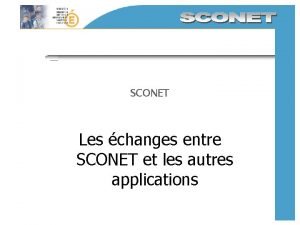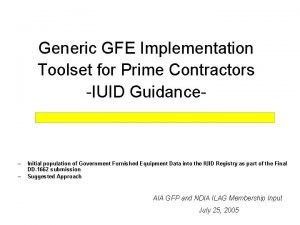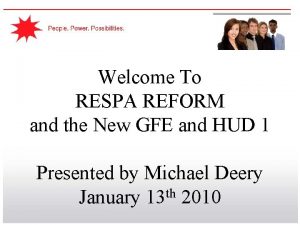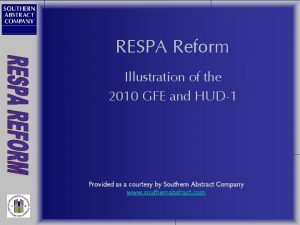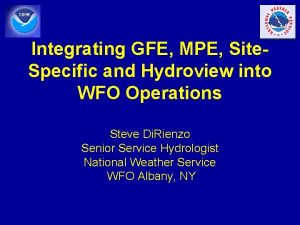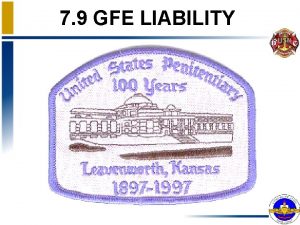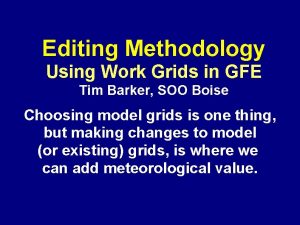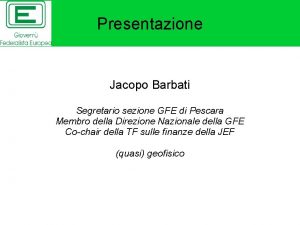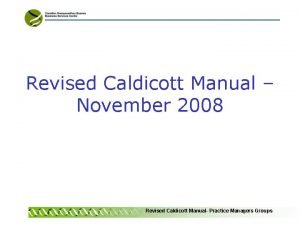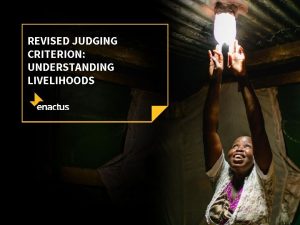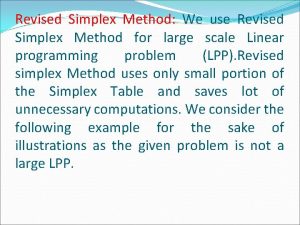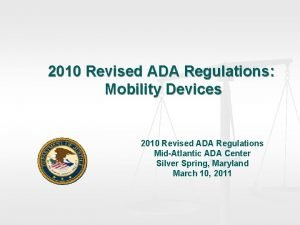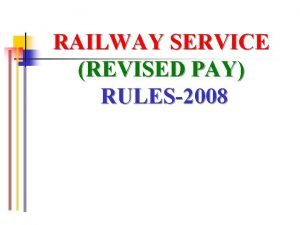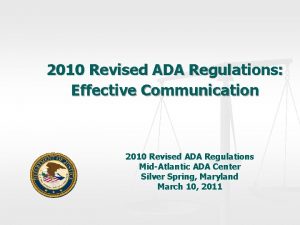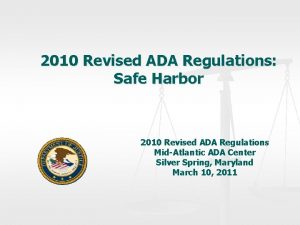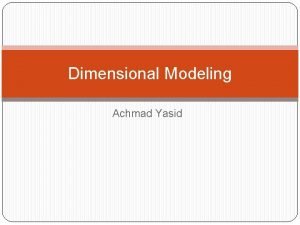A Review of the Revised GFE and HUD1























- Slides: 23

A Review of the Revised GFE and HUD-1 from the Perspective of the Closing Attorney ©CATIC This presentation is for the express use of CATIC agents and may not be used by others without prior written authorization by CATIC. Last Updated November 23, 2009

The Revised Good Faith Estimate (GFE) In General: Ø The revised GFE form must be used for any loan application taken by a broker or lender after January 1, 2010. Ø Applies to mortgages on all 1 -4 family properties (except home equity line of credit, reverse mortgage and construction mortgage). Ø The lender or mortgage broker must issue the GFE within three business days of receipt of loan application. Ø The lender or broker can collect no upfront fees from the borrower except a credit report fee.

The Revised Good Faith Estimate (GFE) Page 1: Ø Important dates #1 – Lender is not required to lock the interest rate for any period of time. Ø Important dates #2 – Borrower has at least 10 business days to accept the GFE and lock in the settlement charges.

The Revised Good Faith Estimate (GFE) Page 2: Ø Block 1 is for total of all loan origination charges collected by the lender, including processing fees, application fees, administration, document preparation, underwriting, wire, courier, etc. (the total of all “junk” fees), not separately itemized, and including any yield spread premium being paid to a broker. Attorney’s fees charged to prepare loan documents for the lender are considered part of the charge for origination services. The fees disclosed in Block 1 cannot increase at closing. Ø Block 2 is the amount of any points or payment for a “buy down” of the interest rate. A yield spread premium appears as a credit (to offset the expense which appears as part of the total in Block 1). If the interest rate was floating when the GFE was issued, a new GFE must be issued when the rate is locked, if the locked rate results in different interest-rate -dependent charges. The fees disclosed in Block 2 cannot increase at closing.

The Revised Good Faith Estimate (GFE) Page 2 (cont’d): Ø Block 3 is for required third-party services selected by the lender such as appraisal, credit, tax service, flood certification and up-front mortgage insurance premiums. The total of the fees in Blocks 3, 4, 5, 6 and 7 cannot increase by more than 10% at closing. Ø Block 4 is for the cost of lender’s title insurance and all settlement fees. Settlement fees include title search, legal fee, closing costs, courier service and overnight mail, recording service fees, wire fees, travel, release tracking, and any other cost associated with closing of the loan (except owner’s title insurance premium-see Block 5, actual recording fees-see Block 7, and conveyance tax-see Block 8). If a borrower selects an attorney to represent the borrower’s personal interest at settlement, and the service provided by that attorney is separate from the functions necessary to conduct the closing, provide title services or issue the lender’s title insurance policy, this attorney’s charge does not need to be included in Block 4.

The Revised Good Faith Estimate (GFE) Page 2 (cont’d): Block 4 (cont’d): The lender must include with the GFE a list of settlement service providers and, if the borrower uses settlement service providers from that list, the total of the charges in Blocks 3, 4, 5, 6 and 7 cannot increase by more than 10% at closing. If the borrower chooses a settlement service provider that is not on the list, the amount charged at closing is not limited by the GFE.

The Revised Good Faith Estimate (GFE) Page 2 (cont’d): Ø Block 5 is for the cost of owner’s title insurance (not applicable in a refinance). The amount to be disclosed is the difference between the rate for the loan policy alone (which is included in Block 4) and the premium for an owner’s policy. This fee, together with the charges in Blocks 3, 4, 6 and 7, cannot increase by more than 10% at closing if the borrower chooses settlement service providers from the lender’s list. Ø Block 6 is for other services required by the lender for which the borrower can shop, such as a survey or termite inspection. If the lender requires any such service as a condition of the loan, the lender must give the borrower a list of providers and, if the borrower uses providers from the list, the total of these fees and the fees in Boxes 3, 4, 5 and 7 cannot increase by more than 10% at closing.

The Revised Good Faith Estimate (GFE) Page 2 (cont’d): Ø Block 7 is for the recording fees paid to the town clerk/county agencies. The total of the charges in Blocks 3, 4, 5, 6 and 7 cannot increase by more than 10% at closing. Ø Block 8 is for conveyance tax paid to the town and the state (not applicable in a refinance). The fees disclosed in Block 8 cannot increase at closing. Ø Blocks 9 and 10 are for escrows and per diem interest. These charges may change at closing. Ø Block 11 is for homeowner’s insurance and flood insurance. The lender is not required to give a list of providers, and the charges may change at closing.

The Revised Good Faith Estimate (GFE) Changed Circumstances: Ø After the GFE is issued, the charges can change in the event that there are “changed circumstances. ” “Changed circumstances” is defined as (1) Acts of God, war, disaster, or other emergency; (2) Information particular to the borrower or transaction that was relied on in providing the GFE and that changes or is found to be inaccurate after the GFE has been provided, which information may include information about the credit quality of the borrower, the amount of the loan, the estimated value of the property, or any other information that was used in providing the GFE; (3) New information particular to the borrower or transaction that was not relied on in providing the GFE; or (4) Other circumstances that are particular to the borrower or transaction, including boundary disputes, the need for flood insurance, or environmental problems. None of the information collected by the loan originator prior to issuing the GFE may later become the basis for a changed circumstance upon which a loan originator may offer a revised GFE, unless the loan originator can demonstrate that there was a change in the particular information or that it was inaccurate, or that the loan originator did not rely on that particular information in issuing the GFE. Examples of changed circumstances include:

The Revised Good Faith Estimate (GFE) Changed Circumstances (cont’d): • Discovery of additional documents (such as releases) that must be recorded. • The property address provided by the applicant turns out not to be the correct, legal address. • The borrower does not proceed to closing quickly upon final approval or does not act diligently in providing information to the lender. • Government Sponsored Enterprises (GSE), FHA or Mortgage Insurance program changes. • Parties are added to or removed from title or the property is moved into or out of trust.

The Revised Good Faith Estimate (GFE) Changed Circumstances (cont’d): • The property use may change, such as from owner-occupied to rental property. • A party will be using a POA to sign, which may require additional work and additional fees. • Changes in recording fees, if the lender was unaware of the pending change. • An additional service such as an additional pest, structural or other inspection, upgraded appraisal, certification, survey or other requirement that is required by the loan originator in connection with the transaction. • The borrower’s credit score changes.

The Revised Good Faith Estimate (GFE) Changed Circumstances (cont’d): Ø When there is a changed circumstance the lender must issue a revised GFE within three business days of receiving the information sufficient to establish changed circumstances. Ø The lender may change only those charges and terms that are affected by the specific changed circumstance.

The Revised HUD-1 Page 2: Ø 700 Series – Real Estate Commissions: The percentage used to compute the sales commission has been removed. The total amount of the commission to each real estate broker or agent must be shown on Lines 701 and 702. The amount of the commissions disbursed at settlement must be shown inside the columns on Line 703. If a real estate agent is holding the borrower’s earnest money deposit, the amount of the earnest money deposit applied towards the commission and the party holding the earnest money must be identified on Line 704 of the HUD-1 as Paid Outside of Closing or P. O. C. Only the amount of the commission disbursed at settlement is entered in the columns on Line 703.

The Revised HUD-1 Page 2 (cont’d): Ø 800 Series – Bank Fees: Line 801 includes all charges received by a loan originator, except for any additional charge (points) for the interest rate chosen on the loan. The amount on Line 801 also includes all amounts received for any service, including administrative and processing services, performed by or on behalf of the lender or any mortgage broker. (The amount on Line 801 is not listed in the columns. ) Ø On Line 802 all payments from a lender to a mortgage broker must be shown as a credit to the borrower. (The amount on Line 802 is not listed in the column. )

The Revised HUD-1 Page 2 (cont’d): Ø 800 Series – Bank Fees (cont’d): Line 803 is the total of 801 and 802 and appears in the column. Ø Lines 804 and following are for third-party settlement services that are required by the lender where the lender has selected the provider. These third-party services and fees most often include appraisals, credit reports, flood searches, tax service, and governmental loan program charges, such as VA and FHA.

The Revised HUD-1 Page 2 (cont’d): Ø 900 Series – Items required by the lender to be paid in advance: The 900 series is for interest and insurance required by the lender to be paid at or before closing. If the borrower pays the homeowner’s insurance prior to closing, the charge should be shown on Line 903 of the HUD-1 noted as Paid Outside of Closing or P. O. C. with the charge to the left of the column. Line 904 may be used for flood insurance, if required. Ø 1000 Series – Escrows Line 1001 is the total of all escrow items and is entered in the column. The different types of escrows that make up the total are listed beginning on Line 1002, but do not appear in the column. The aggregate adjustment appears on the last line of the 1000 series in the column as a credit.

The Revised HUD-1 Page 2 (cont’d): Ø 1100 Series – Title Charges The total of the lender’s portion of the title insurance and the charge for all title services is entered in the column on Line 1101. The term “title services” includes: • • • • Any service involved in the provision of title insurance Title Examination and evaluation Preparation and issuance of commitment Clearance of underwriting objections Preparation and issuance of policies Document preparation fees Delivery fees Copy fees Wire and bank fees Travel fee Settlement or closing fee Attorney’s fee Any other cost associated with the closing of the loan

The Revised HUD-1 Page 2 (cont’d): Ø 1100 Series – Title Charges (cont’d) The closing fee (attorney fee) is entered on Line 1102, but not in the column. If a borrower selects an attorney to represent the borrower’s personal interests at settlement, and the service provided by that attorney is separate from the functions necessary to conduct the closing, provide title services or issue the lender’s title insurance policy, this attorney’s charge may be separately listed on a blank line in the 1100 series in the borrower’s column along with the name of the attorney and the type of service provided. The amount of this attorney’s fee should not be included in the charge listed on Line 1101. Any other settlement fees paid to third parties, such as a title search fee or recording service fee, must be entered at the end of the 1100 series outside of the column with the amount paid and the name of the service provider.

The Revised HUD-1 Page 2 (cont’d): Ø 1100 Series – Title Charges (cont’d) On a purchase transaction, the charge for the owner’s title insurance appears in the column on Line 1103. The amount to be entered is the difference between the rate for the loan policy alone and the premium for an owner’s policy. The amount for the lender’s title policy is entered on Line 1105 outside of the column. Ø 1200 Series – Recording Fees and Conveyance Tax Line 1201 is used to record the total government recording charges. Additional items the lender requires to be recorded, other than those already enumerated in Line 1202, must be itemized on additional lines in the 1200 series. The charges for these additional items must be stated outside the column. Line 1203 is the total of the state and local conveyance taxes. The taxes are itemized outside of the column in Lines 1204 and 1205.

The Revised HUD-1 Page 2 (cont’d): Ø 1300 Series - Additional Settlement Charges Line 1301 is the total of all charges for third party settlement services that the loan originator required but for which the borrower was permitted to select the service provider. The charge on Line 1301 is shown in the borrower’s column. All charges included in the total amount on Line 1301 must be separately itemized outside of the columns in Line 1302 and subsequent lines, identifying the types of service, the name of the provider, and the amount of the charge. If Line 1302 and additional sequentially numbered lines are needed to record required services that the borrower can shop for, the settlement agent may list the itemized miscellaneous settlement services beginning in Line 1302.

The Revised HUD-1 Page 3: Ø The settlement agent must complete the comparison chart at the top of Page 3. The numbers for the “Good Faith Estimate” column must be supplied by the lender. The numbers for the “HUD-1” column will be taken from the appropriate lines of Page 2. The “HUD-1” column must include any amounts shown on Page 2 of the HUD-1 in the column as paid by the borrower, plus any amounts that are shown as P. O. C. by or on behalf of the borrower. Ø If any of the charges in the first section (Charge that Cannot Increase) exceed the Good Faith Estimate, the loan is out of tolerance. Likewise, the loan is out of tolerance if the total of the charges in the second section increases by more than 10% from the GFE.

The Revised HUD-1 Page 3 (cont’d): Ø The lender is responsible for curing tolerance violations. The settlement agent does not need to stop the closing if a tolerance violation occurs. While HUD recommends that the lender cure the tolerance violation at closing, the lender has 30 calendar days to cure. The lender is responsible for making a reimbursement to the borrower. Upon reimbursement, the settlement agent must correct the HUD-1 and provide copies of the corrected HUD-1 to the borrower, seller, and lender, as applicable. Ø The lender must provide information to the settlement agent in a format that permits the settlement agent to simply enter the necessary information to complete the “Loan Terms” section on the bottom of Page 3 without having to refer to the loan documents.

For More Information: URL for HUD’s Frequently Asked Questions: http: //www. hud. gov/offices/hsg/ramh/resparulefaqs. pdf
 Gfe meaning
Gfe meaning Sconet bee
Sconet bee Gfe vs gfp
Gfe vs gfp Betts neihart profiles of the gifted and talented
Betts neihart profiles of the gifted and talented 2021 revised curriculum and assessment plans
2021 revised curriculum and assessment plans 2020 revised curriculum and assessment plans
2020 revised curriculum and assessment plans Revised curriculum 2020
Revised curriculum 2020 2020 revised curriculum and assessment plans
2020 revised curriculum and assessment plans Revised curriculum and assessment plans 2021
Revised curriculum and assessment plans 2021 2020 revised curriculum and assessment plans
2020 revised curriculum and assessment plans 2020 revised curriculum and assessment plans
2020 revised curriculum and assessment plans 2020 revised curriculum and assessment plans
2020 revised curriculum and assessment plans 2020 revised curriculum and assessment plans
2020 revised curriculum and assessment plans 2020 revised curriculum and assessment plans
2020 revised curriculum and assessment plans 2020 revised curriculum and assessment plans
2020 revised curriculum and assessment plans 2020 revised curriculum and assessment plans
2020 revised curriculum and assessment plans Revised programme of assessment 2020
Revised programme of assessment 2020 2020 revised curriculum and assessment plans grade 6
2020 revised curriculum and assessment plans grade 6 2020 revised curriculum and assessment plans
2020 revised curriculum and assessment plans 2020 revised curriculum and assessment plans
2020 revised curriculum and assessment plans 2020 revised curriculum and assessment plans grade 7
2020 revised curriculum and assessment plans grade 7 2020 revised curriculum and assessment plans
2020 revised curriculum and assessment plans 2020 revised curriculum and assessment plans grade 7
2020 revised curriculum and assessment plans grade 7 2020 revised curriculum and assessment plans
2020 revised curriculum and assessment plans

